State of the Overseas Voter
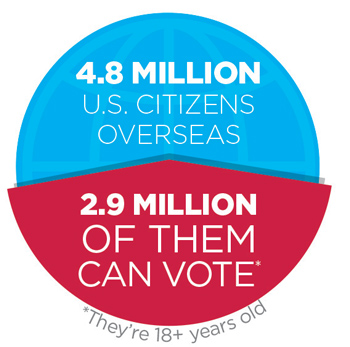
Nearly 3 million U.S. citizens living abroad can vote absentee — in many cases, even if they have never resided in the United States. They're covered by the Uniformed and Overseas Citizens Absentee Voting Act (UOCAVA) of 1986, which requires that states allow military members, their eligible family and overseas citizens to vote absentee in federal elections.
Voting is more complicated for citizens living abroad than for local voters. They have to update their registration and explicitly request an absentee ballot — potentially every year. They have to follow their state's rules on how election paperwork can be sent and received, which may require technology not readily available or long mailing times. Most need to vote earlier than local voters so that their ballots are received by voting deadlines.
To learn more about overseas voters and help them navigate the absentee voting process, FVAP conducts the Overseas Citizen Population Analysis (OCPA) every two years following the general election. It combines data from U.S. and foreign governments, state records of ballot requests and voting, and a survey of 5,282 overseas citizens who requested an absentee ballot for the 2020 General Election — the only representative survey of this group.
Impact of the COVID-19 Pandemic
The pandemic most notably affected overseas voters' ability to use international mail. While our overseas military were able to continue to send and receive mail, from March through November 2020, international mail access varied based on health conditions in each respective country. At one point, disruptions occurred simultaneously in over 140 countries. Additionally, voters in certain cities reported being prohibited from traveling across the city to drop off a voted ballot at an embassy or consulate.
FVAP, the U.S. Postal Service and the Military Postal Service Agency established a central COVID-19 resource for voters and election officials for monitoring international mail conditions and identifying options for returning voted ballots. They provided voters with Department of State guidance on the level of service provided in each country, with current information on temporary closures at embassies and consulates.
The Overseas Voter in 2020: 35 Years of UOCAVA
Since there is no list of all U.S. citizens living abroad, FVAP compiles foreign and domestic data to estimate the number of voting-age U.S. citizens living in nearly 200 countries around the world.
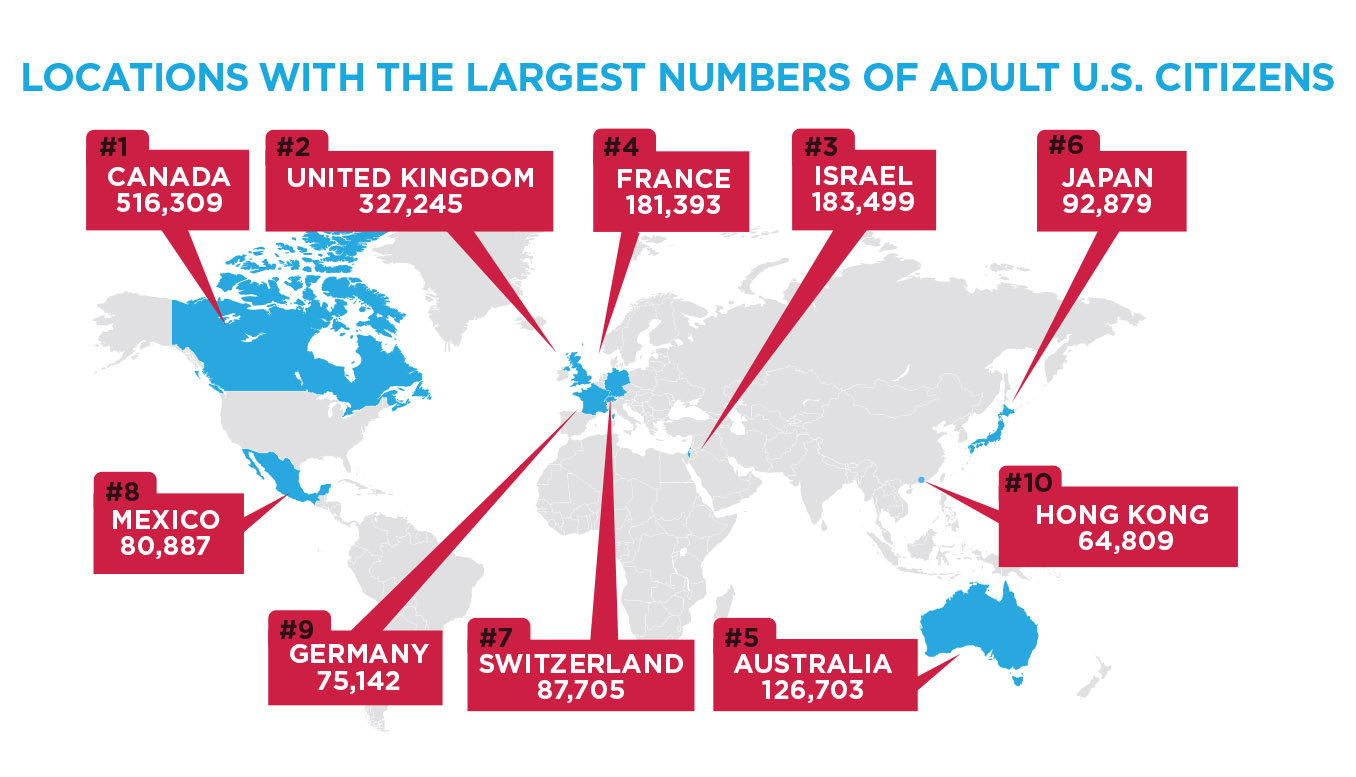



North America (excluding the United States) and Europe contain the most voting-age U.S. citizens, although countries from other regions of the world also rank among the top 10.
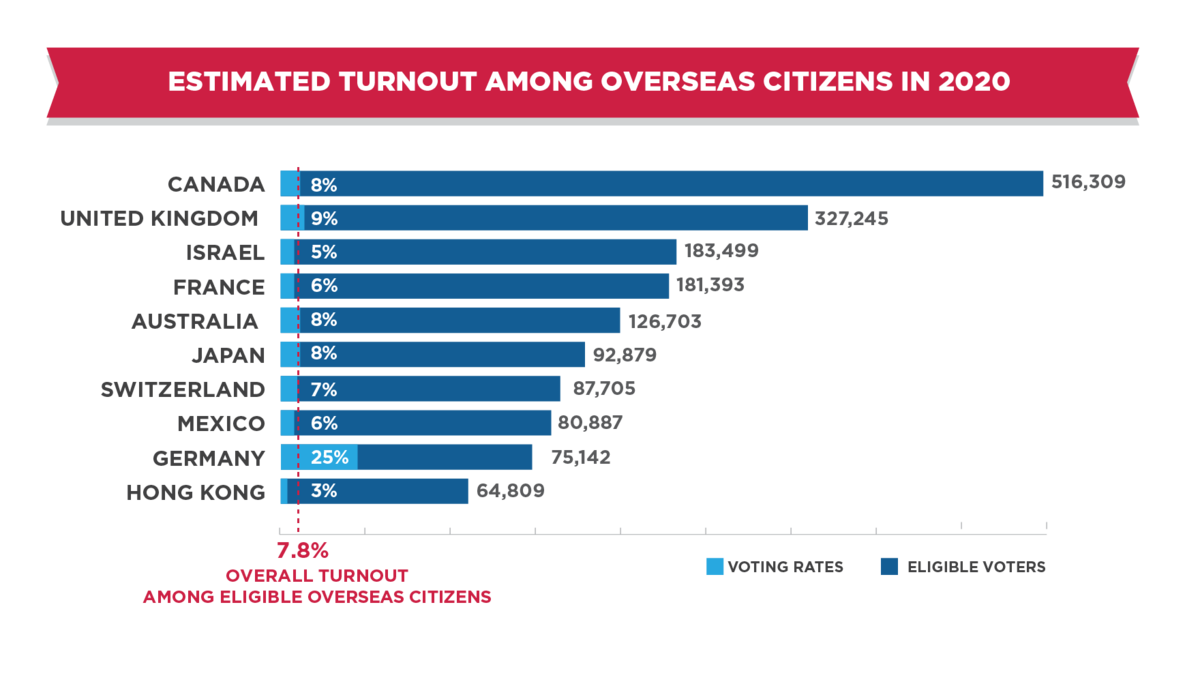




FVAP then uses the population estimates and state data on absentee ballot requests and returns to estimate how many U.S. citizens in each country voted in the U.S. general election and calculates an overall turnout rate for overseas citizens.
Overseas citizen turnout varies from country to country. While it is within a couple of percentage points of the overall rate of 7.8% in many countries, turnout can be many points higher or lower in some countries, such as Germany and Hong Kong.
Compared to people living in the United States, citizens living abroad are much less likely to vote in federal elections. FVAP calls the difference the voting gap. While some overseas citizens don't want to vote, in 2020 over half of the gap between domestic and overseas voting rates could be attributed to real or perceived obstacles overseas citizens encountered while trying to vote that domestic voters do not face.
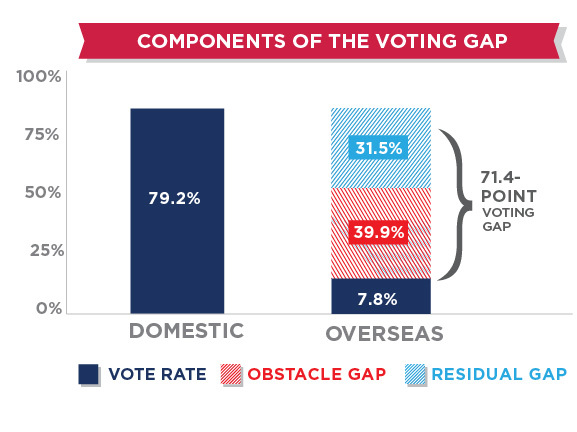



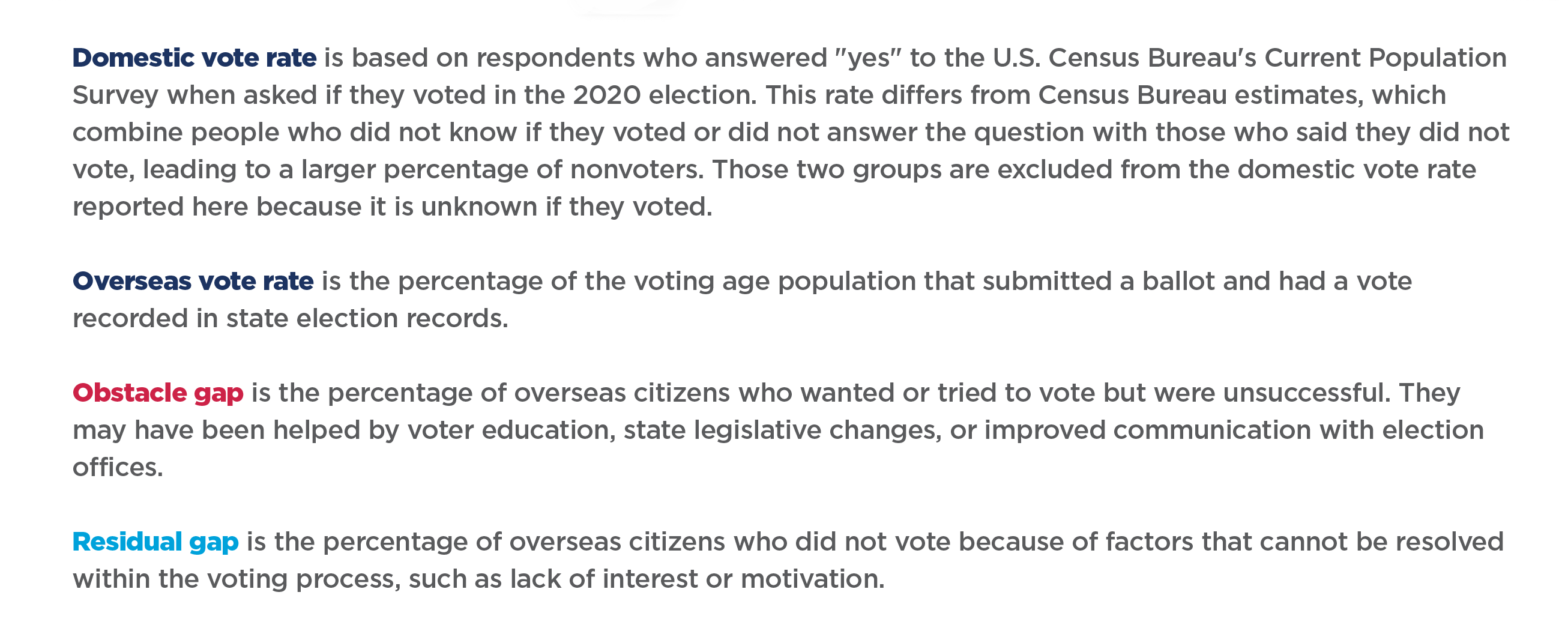



The portion of the voting gap attributable to real or perceived obstacles varies substantially among different regions of the world, with high-obstacle countries concentrated in Eastern Europe, Asia, Latin America and Africa. FVAP's Interactive Data Center includes a map categorizing each country by the size of its obstacle gap.
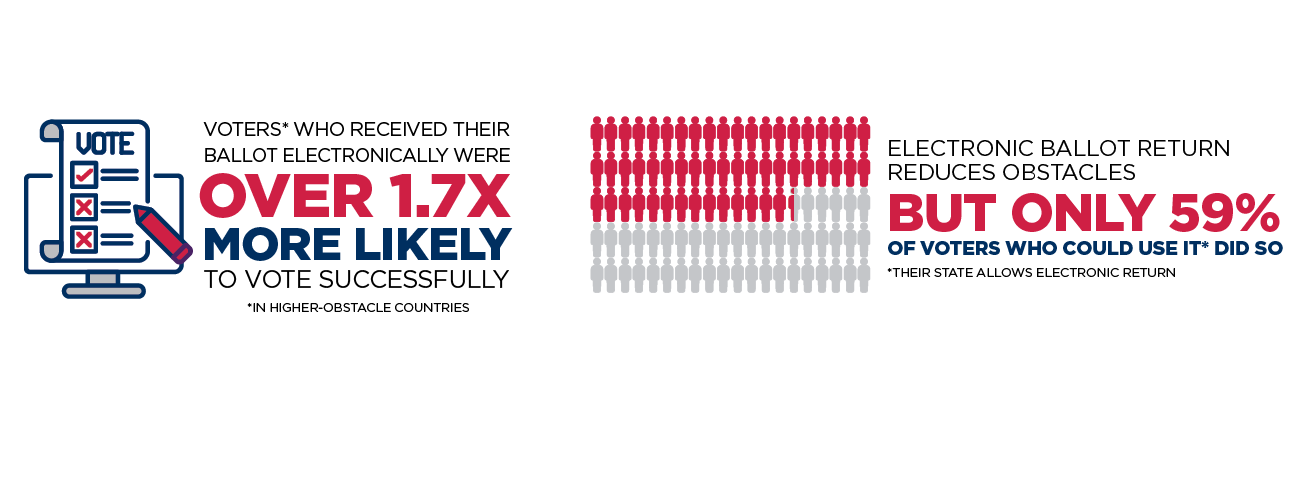



In 2020, the three most common problems overseas voters encountered were difficulties with the mailing system, difficulties requesting a ballot, and difficulties returning a ballot.
The report on overseas citizens and their voting behaviors in 2020 includes:
Data on U.S. Citizens Living and Voting from Abroad
FVAP conducts the Overseas Citizen Population Analysis (OCPA) after each federal election cycle to meet its federal requirement for a statistical analysis of overseas citizen participation rates. The study estimates the number of U.S. citizens living abroad, assesses overseas voting participation, monitors how voters are navigating the absentee voting process from abroad, and informs efforts to remove obstacles.
This State of the Overseas Voter highlights recent statistics on the numbers of voting-age citizens living overseas and their voting experiences. More information on U.S. voters living abroad can be found in FVAP's Interactive Data Center, Post-Election Report to Congress, and the OCPA technical reports.
Each time the OCPA is conducted, the estimating methodology is updated with newly available data. As a result, the population estimates become more accurate over time. The 2018 report incorporated new data sources for foreign government estimates and Gross Domestic Product (GDP), as well as updated records of U.S. citizens living overseas who filed taxes using a foreign address. The latest report uses the population estimates of the numbers of U.S. citizens living in foreign countries from 2018 and combines them with data from the 2020 Overseas Citizen Population Survey to estimate voting rates of the overseas citizen voting-age population in the 2020 General Election. It also compares the rate to that of the citizen voting-age population living in the United States; determines how much of the difference in participation is due to obstacles unique to the overseas voting process; and assesses how these obstacles can be mitigated.
See all previous volumes of the Overseas Citizen Population Analysis:
Separately, FVAP releases research on the voting experiences of citizens serving on active military duty as part of the State of the Military Voter.
Frequently Asked Questions
- What has changed since the 2018 Overseas Citizen Population Analysis (OCPA)?
For the 2020 survey, the sample frame was drawn from state voter files available by January 2020 and data was collected from respondents between March and June 2021. This differed from previous iterations of the survey, where frame and survey data was collected in the fall and winter following a General Election cycle. Consequently, the frame from which the sample was drawn overrepresents states that provided a voter file earlier. However, the sample was weighted such that it was representative of ballot requesters from all states (early and late reporting) with respect to vote history, geography, and other attributes. Because the population estimates produced for the 2018 OCPA were updated using available data as of late 2019, these estimates were not updated for purposes of the 2020 OCPA. FVAP continuously seeks to improve population estimation methodology and will be undertaking a rigorous assessment of methodology before the next iteration of this project in 2022.
- Why do the estimated numbers of total and voting-age U.S. citizens living abroad for the years 2000-2014 differ between the 2014, 2016, 2018, and 2020 OCPA reports?
Since the first OCPA analysis was conducted in 2014, additional data have been added as they became available. Particularly, additional estimates of the number of U.S. citizens living in specific countries and updated data about GDP and foreign tax filings were added to population estimation models. Because the data changed, the models changed, and thus the final estimates for the 2000 - 2016 period differ from those in previous OCPA reports. It is important to note that although the exact numbers differ, the general population patterns remain largely the same as those reported previously. Going forward, as new data become available for future iterations of the OCPA, and as methodologies used to clean and impute that data become more refined, estimates for a given year will change.
2018 OCPA estimates were produced in late 2019 and were based on data that has not been updated as of the 2020 OCPA; therefore, the 2020 report references 2018 OCPA estimates.
- What were the primary objectives of the OCPA project?
The Federal Voting Assistance Program (FVAP) first conducted the OCPA in 2014 with a twofold goal: (a) gain a greater understanding of the voting behavior of U.S. citizens living overseas during the 2014 General Election, and (b) fulfill a requirement for reporting registration and participation rates among overseas citizens pursuant to the Uniformed and Overseas Citizens Absentee Voting Act (UOCAVA).
The 2020 OCPA is the fourth iteration of this study and maintains the goal of understanding and reporting on the status of overseas voting registration and participation. This research effort involved creating estimates of the number of U.S. citizens in each foreign country and conducting a survey of registered overseas voters. Results allow FVAP to track overseas voter participation rates over time and to determine what types of challenges and obstacles overseas citizens face when they seek to cast a ballot.
The OCPA uses data from the Overseas Citizen Population Survey (OCPS) to examine the voting experiences of registered U.S. citizens who live abroad. While previous iterations of the OCPS were fielded in the fall following an election year, the 2020 OCPS was fielded in the spring to gather data about overseas citizens closer to the General Election.
The fielding of the 2022 OCPS is in the spring of 2023, with the results and analyses being available in the fall of 2023.
- Has anyone ever calculated the voting rate of overseas U.S. citizens before?
There have been attempts to calculate an overall voting rate for overseas citizens; however, the 2014 OCPA was the first project that assembled the data necessary to estimate the overseas citizen voting-age population, which is a critical requirement for calculating voting rates. Throughout this effort in 2020, FVAP and its researchers completed several subgoals, including:
- Estimating an aggregate voting rate of the overseas civilian population in the 2020 General Election. To calculate this, we divided the number of 2020 General Election ballots that were recorded by local election officials by our estimate of the total number of voting-eligible overseas citizens.
- Estimating the voting rate of the subset of voting-eligible overseas citizens who actively requested a ballot. To do this, we divided the number of 2020 General Election ballots that were requested by overseas citizens by the number of 2020 General Election ballots that were received from overseas citizens and recorded by local election officials.
- Estimating what the voting rate among overseas citizens would have been absent overseas-specific obstacles to voting, and thus the impact of those obstacles on the participation by UOCAVA citizens in the 2020 General Election.
- Has anyone else ever produced estimates of the number of U.S. citizens living overseas?
The United Nations and World Bank have produced estimates of the number of U.S.-born or U.S. citizens living overseas by country. FVAP produced estimates of the number of overseas U.S. citizens in 2013, but these estimates included all overseas U.S. citizens, not just those who were old enough to vote (i.e., those aged 18 or older). In each OCPA, FVAP has estimated the number of total overseas citizens and the number that are voting age for each year going back to 2000. Because the estimating methodology is improved each time the OCPA is conducted, estimates in later reports may differ from those in earlier OCPA reports. In 2004, the U.S. Census Bureau piloted a program to assess the feasibility of including overseas citizens in its decennial census, but the study found that full implementation would be prohibitively expensive and would not produce a level of data quality consistent with Census standards.[i] In previous years, the Department of State has released estimates of the number of overseas civilians; however, these numbers are used for contingency operations and appropriately result in an overestimation.
- Why does the OCPA rely on estimates of overseas citizens? Doesn't the U.S. Department of State know how many Americans are abroad?
Individuals who travel or live abroad can register with their local embassy to receive alerts from the Department of State, but no official registry is kept. Registries that do exist include citizens on short-term travel as well as long-term relocation, and there is no process to remove duplicates if individuals register at more than one embassy or to remove people from the list who have returned to the United States. In previous years, the Department of State has released estimates of the number of overseas civilians; however, these numbers are used for contingency operations and appropriately result in an overestimation.
- How are FVAP's OCPA estimates of overseas citizens different from estimates created by other groups?
Previous population estimates created by other groups: (a) excluded key countries; (b) were produced for years before 2014; or (c) used different definitions of U.S. citizens or methods of counting them.
To estimate voting rates, a census of U.S. citizens is preferred, as only citizens can vote and a census is thought to be more reliable than administrative records that may be incomplete or duplicative. The OCPA research team compiles data from many different sources to create statistical estimates of what a government census of the number of U.S. citizens (including dual citizens) in each of 186 countries would be. These sources include registries and censuses kept by foreign governments, administrative records from U.S. agencies (e.g., foreign income tax filers, social security beneficiaries, civilian government employees, students), and a set of country characteristics that may affect immigration to or from that country, such as the distance from the United States, the quality of governance/institutions, and the primary language of the country. A similar modeling approach was used to estimate the fraction of the total U.S. citizen population that was eligible to vote (i.e., aged 18 or older). Summing the voting-eligible population across countries provided an estimate of the total size of the Overseas Citizen Voting-Age Population (OCVAP).
- Why does the OCPA estimate for a given country differ from that provided by the country's government?
Governments vary with respect to how they define their "American" population as well as how they count it. Some governments count individuals born in the United States whereas others count those with U.S. citizenship. Even among those governments providing counts of citizens, it is unclear whether dual citizens (those who are both citizens of the United States and the host country) are included. Counting methods also vary, with some governments using a census and others using administrative records. As noted in Question 5, the OCPA uses a statistical model to estimate, for each country, the number of U.S. citizens that would be counted in a population census.
These measurement differences, as well as idiosyncratic features of the country or its estimate not captured by our model, can result in an OCPA estimate for a given country that differs substantially from the estimate provided by the country's government or other sources.
- Has anyone ever conducted a survey of overseas U.S. citizens?
The lack of a comprehensive list of overseas citizens makes it difficult to conduct such surveys. The Overseas Citizen Population Survey (OCPS), a component of the larger OCPA project, is a survey of overseas voters who requested an absentee ballot. It builds on past surveys conducted by FVAP and other organizations by using a more rigorous and inclusive sampling method. FVAP also conducted a survey of overseas citizens in 2004, which was distributed through embassies in various locations.[ii] More recent efforts include the work of private organizations like the Overseas Vote Foundation (OVF), which conducts a voting survey of its website users, many of whom are current overseas voters. Although all of these studies provided valuable information, none met the "gold standard" criterion: selecting respondents from a list of people in a way that each has an equal chance, or probability, of being surveyed. The 2014 OCPS marked FVAP's first effort to survey overseas U.S. citizens in this manner.
The primary difference between the OCPS and many other surveys is the ability to generalize survey results to the broader population of overseas voters. This is possible because the survey draws from a comprehensive list of overseas voters who requested an absentee ballot. The OCPS sample frames were developed by obtaining data from absentee ballot request files maintained by state and local election officials. A stratified sample of ballot requesters was then selected and invited to participate in the survey. Finally, the data were weighted to accurately reflect the absentee ballot-requesting population as a whole and not just the survey respondents.
- How do you know how many people voted from each country? Aren't voting records private?
The total number of votes that were counted from overseas civilians can be obtained from the U.S. Election Assistance Commission's (EAC) Election Administration and Voting Survey (EAVS), which is a survey of state and local election officials. However, this survey only reports the aggregate count of overseas ballots within a jurisdiction, not the country from which votes were submitted. Consequently, FVAP produced its own count of registered overseas voters by obtaining data from absentee ballot request files maintained by state and local election officials. Knowing how many voters were in each country allowed us to calculate country-specific voting rates.
- Is the fraction of the overseas population that is of voting age really that small?
Estimates of the total overseas citizen population and the eligible overseas population are produced using sophisticated technical models, but ultimately, there will always be a level of uncertainty about the true number of overseas citizens. However, there are several reasons that the overseas citizen population might tend to be younger than the domestic population, including the various rules that govern who is considered a U.S. citizen and well-documented patterns of migration to and from the United States.
The OCPS collected data on the citizenship and family status of overseas citizens who requested an absentee ballot from an address outside of the United States. Among respondents who reported being married, slightly over one-half (62%) indicated that their spouse does not have U.S. citizenship. Although this sample of overseas ballot requesters is not necessarily representative of the general overseas population, there is little reason to think this proportion represents an overestimate relative to the general overseas population.
There is quite a bit of geographic variation in the proportion of overseas citizens who are aged 18 or older. For instance, in 2018, 84% of U.S. citizens residing in the United Kingdom and 84% of those residing in Germany are estimated to be 18 or older, whereas only 14% of U.S. citizens residing in Mexico and 23% of those residing in India are estimated to be 18 or older. To some extent, this mirrors overall population trends in these countries, where relatively high birth rates in Mexico and India mean that the overall population tends to be younger in those countries. These statistics are also influenced by the return migration of children who are U.S. citizens born to parents who are not. In the case of Mexico, high levels of return migration have been documented. [iii]
- That sounds like a very low voting rate. Are the obstacles to voting outside the United States really that large?
The estimated voting rate of overseas citizens is low compared to the voting rates estimated for other populations, including active duty military (ADM). Myriad factors might lead to this lower rate of participation among this overseas citizen population: obstacles in the voting process, lack of engagement, disinterest in U.S. elections, etc. [iv]
In the OCPA reports, we (a) estimate the effect of obstacles to voting on participation by comparing vote rates for high- and low-obstacle countries; (b) using these estimated effects, determine what the overseas civilian voting rate would have been absent overseas-specific obstacles to voting; and (c) take the difference between this obstacle-free vote rate and the estimated actual vote to obtain an estimate of how much of the overseas civilian participation gap is due to these obstacles. We estimate that about half (56%) of the approximate 72 percentage point participation gap is due to overseas-specific obstacles to voting.
- Why aren't military Service members included? How did you make sure they were excluded? Where can I find info about (overseas) military voting?
FVAP's mission is to provide voting assistance to military Service members, their families, and overseas citizens. This particular study focused on the last group as FVAP conducts other studies on military registration and participation rates. To control for any overlap, absentee ballot requesters that a state or local election official flagged as "Military" or whose address was on a military base were not invited to participate in the OCPS. In addition, OCPS respondents who indicated that they were serving in the military were excluded from the analysis. More information about military voting can be found at FVAP.gov.
- What is the difference between an overseas citizen and an overseas voter? Can all overseas citizens also be considered overseas voters?
An overseas citizen is defined as a citizen of the United States who is living or located in another country and who is not a Service member on active duty or a dependent of one. If an overseas citizen is at least 18 years old, he or she is defined as part of the Overseas Citizen Voting-Age Population (OCVAP), which constitutes the voting-eligible population for the purposes of this study.
A registered overseas voter is defined as a member of the OCVAP who has specifically registered to vote and has filled in an overseas address in the mailing address section on their registration and ballot request form. All registered overseas voters are overseas citizens, but not all overseas citizens are registered overseas voters. The population represented in OCPS is the subset of overseas citizens who are registered overseas voters.
References
[i] Government Accountability Office. (2004). 2010 Census: Counting Americans overseas as part of the Census would not be feasible. Washington, DC: U.S. Government Accountability Office. Retrieved from https://www.gao.gov/new.items/d041077t.pdf
[ii] Federal Voting Assistance Program. (2005). The Federal Voting Assistance Program: Seventeenth report. Washington, DC: Department of Defense. Retrieved from https://www.fvap.gov/uploads/FVAP/Reports/17threport.pdf
[iii] González-Barrera, A. (2015). More Mexicans leaving than coming to the US. Pew Research Center, 19. Retrieved from http://www.pewhispanic.org/2015/11/19/more-mexicans-leaving-than-coming-to-the-u-s/
[iv] Greater detail on the relative importance of these factors can be found in the 2016, 2018, and 2020 reports.




